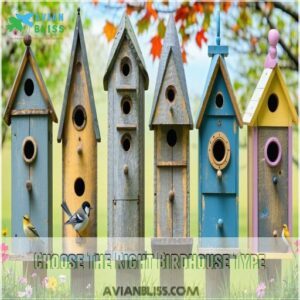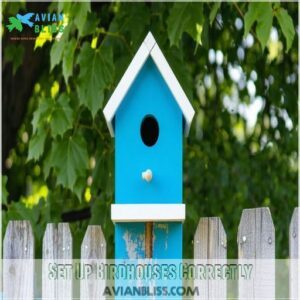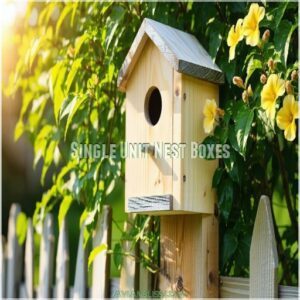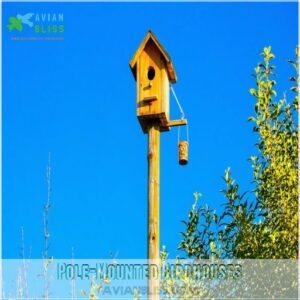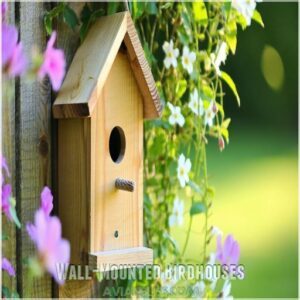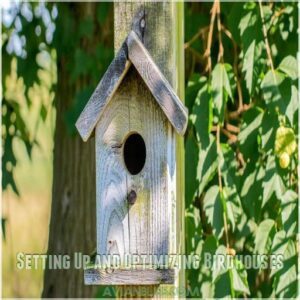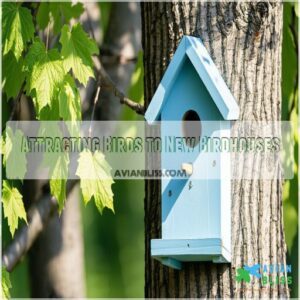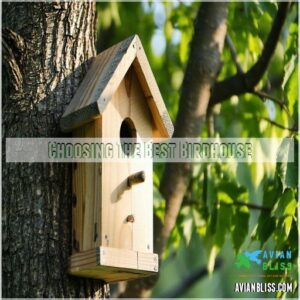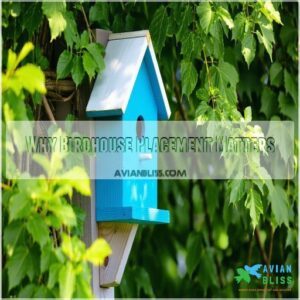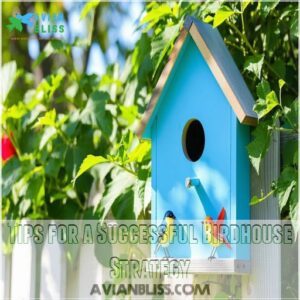This site is supported by our readers. We may earn a commission, at no cost to you, if you purchase through links.

Make sure it’s safe from predators and placed in a quiet, inviting spot with easy bird access.
Scatter nesting materials nearby, kind of like setting the table before dinner.
Keep the birdhouse clean to make it a welcoming home.
Patience is key—sometimes birds take their sweet time to settle in.
Adding bird feeders and water sources nearby can also entice them.
Consider these steps, and you might discover tiny avian tenants exploring your backyard soon.
There’s much more to explore on this topic!
Table Of Contents
- Key Takeaways
- What Species of Birds Will Be Attracted
- How to Attract Birds to Birdhouses
- Types of Birdhouses That You Can Use
- Setting Up and Optimizing Birdhouses
- Attracting Birds to New Birdhouses
- Choosing The Best Birdhouse
- Where to Hang a Birdhouse
- Why Birdhouse Placement Matters
- Maintaining and Cleaning Birdhouses
- Tips for a Successful Birdhouse Strategy
- Frequently Asked Questions (FAQs)
- How do I attract birds to my Birdhouse?
- Should you put up a birdhouse?
- How do I choose a birdhouse?
- Can birdhouses be used for nesting?
- Are birdhouses a good addition to a backyard?
- How do you attract nesting birds?
- How do I get birds to come to my birdhouse?
- Why don’t birds go in my birdhouse?
- What color birdhouse attracts birds the most?
- How long does it take for a bird to find a birdhouse?
- How do weather conditions affect birdhouse use?
- What colors attract birds to birdhouses?
- Can I use recycled materials for birdhouses?
- How do I prevent ants in birdhouses?
- Are there plants that encourage birdhouse visits?
- Conclusion
Key Takeaways
- Pick the right birdhouse tailored to the species you want by considering local bird size and entrance needs to effectively attract them.
- Place birdhouses in secure, quiet spots away from predators and busy areas, ensuring comfort and safety for cavity-nesting birds.
- Keep birdhouses clean and offer natural nesting materials nearby to encourage birds to settle in and maintain a healthy environment.
- Enhance the habitat with bird feeders and water sources to make your backyard a welcoming bird-friendly spot and attract more avian visitors.
What Species of Birds Will Be Attracted
Deciding which bird species you’ll attract with your birdhouse can be both exciting and essential to success.
Most cavity-nesting birds, like chickadees, bluebirds, and swallows, will make your birdhouse their home.
While cardinals and goldfinches prefer open spaces for nesting.
Common Bird Species That Use Birdhouses
If you’ve ever wondered which bird species will flock to birdhouses, here’s the scoop.
Many cavity-nesting birds love a cozy birdhouse.
1. Bluebirds often choose well-placed houses in open spaces, such as open fields or meadows with sparse trees, where a bird house for bluebirds can be effectively mounted.
2. Chickadees prefer birdhouse designs nestled among trees.
3. Woodpeckers look for birdhouses with proper size and nesting materials.
Knowing their nesting habits helps attract birds effectively.
Birds That Prefer Open Nests
Not all birds are fans of birdhouses.
Cardinals and goldfinches prefer open nests, like someone opting for a penthouse view over a cozy cottage.
You’ll often spot them weaving their homes in branches and shrubs.
They love the freedom of open spaces, but these open nest benefits come with risks, as predators find them more accessible.
Birds That Utilize Birdhouses
Discover the secret world of cavity-nesting birds by setting up birdhouses.
Bluebirds, chickadees, and wrens love these cozy shelters.
House sparrows often compete for these spots, so design matters.
Choosing materials and placement wisely can attract various species.
Offer the right birdhouse size and nesting materials, and watch as your backyard becomes a bustling avian neighborhood.
How to Attract Birds to Birdhouses
To attract birds to your birdhouse, start by identifying the species that frequent your area so you can choose the right type of birdhouse design.
Birdhouse Placement is essential for creating a welcoming environment.
Make sure you set it up correctly by considering factors like placement, height, and distance from feeders.
Identify Bird Species in Your Region
So, you’ve got a handle on which birds use birdhouses.
Now, let’s figure out who’s hanging around your neck of the woods!
Knowing your local species is key to attracting them.
Check out some resources to help you identify them.
- Local bird guides
- Birdwatching apps
- Online resources
- Regional bird clubs
- Citizen science projects
These tools can help you pinpoint exactly which feathered friends you can attract to your birdhouses.
Choose The Right Birdhouse Type
Now that you know which birds call your area home, choosing the right birdhouse type is key.
Think about size, material, and design to attract cavity-nesting birds, and consider checking the ideal birdhouse size guidelines for your specific needs.
Single unit nesting boxes suit bluebirds while multi-unit suits martins.
Your birdhouse features should match bird habits—think of it as offering the perfect Airbnb for your feathered friends.
Set Up Birdhouses Correctly
Think like a bird. After picking the right birdhouse, getting the setup right is key.
For ideal placement, consider the bird house installation guide to make sure you’re meeting the specific needs of your target species, such as bluebirds preferring open spaces and wrens preferring wooded areas.
Go for a birdhouse height suited to your visitor’s needs—bluebirds like 5-8 feet while owls prefer 20-40 feet.
Secure placement tips include safe distances from windows and protecting against predators.
Remember, your feathered friends seek comfort, freedom, and security.
Types of Birdhouses That You Can Use
Choosing the right birdhouse type is important for attracting specific bird species to your yard, whether it’s a single unit box for bluebirds or a hanging one for wrens.
You’ll want to think about the variety of styles available—each offering unique benefits based on the birds’ preferences and the environment in your backyard.
Single Unit Nest Boxes
When attracting birds to birdhouses, single unit nest boxes are a top choice for solitary nester species like bluebirds.
They like a snug fit, so think small yet comfy.
Here’s how you nail it:
- Box Size: Tailor it to your bird.
- Placement: Position carefully.
- Entrance: Perfect size matters.
- Care: Regular cleaning keeps guests happy.
Multiple Unit Nest Boxes
For those birds with a penchant for communal nesting, multiple unit nest boxes are your go-to.
Martin houses with multiple entries can attract large colonies, offering safety in numbers.
A dash of humor here: it’s like the bird world’s apartment complex!
Placement is key for predator protection, so set your birdhouses in spots where birds can feel secure and thrive.
| Keyword | Explanation | Benefit |
|---|---|---|
| Communal nesting | Birds sharing homes | Increases social interaction |
| Martin houses | Designed for Purple Martins | Supports larger bird colonies |
| Multiple entries | Many entry holes | Easier access for multiple birds |
| Predator protection | Safety measures in design | Reduces predation risk |
Pole-Mounted Birdhouses
Pole-mounted birdhouses offer a stable, elevated perch for birds, keeping them safe from predators while providing a great view.
With sturdy poles, you guarantee wind resistance and durability.
Aim for a pole height of 5-15 feet, depending on the species you’re attracting.
Use durable materials and include a feeder nearby.
Proper bird house placement with these tips will attract birds effortlessly!
Wall-Mounted Birdhouses
Wall-mounted birdhouses offer a stable, secure home for your feathered friends.
This design is perfect if you lack trees or poles.
Consider sturdy materials like cedar or redwood for longevity.
You can find a variety of wall mount birdhouse options at online stores like everysimply wall mount birdhouse.
Proper installation is key—use strong brackets to prevent falls.
Remember, predator protection is essential; a well-placed wall-mounted birdhouse provides safety.
DIY options abound online, allowing you to create a customized home.
Hanging Birdhouses
Hanging birdhouses add a bit of charm to your garden while attracting feathery tenants.
Set them at a reasonable height, making sure they swing gently for species like house wrens.
Protect from predators and harsh weather by considering stability and shelter.
To maximize success:
- Choose a stable branch or hook.
- Make sure they’ve the proper swinging tolerance.
- Orient for weather protection.
Setting Up and Optimizing Birdhouses
To set up your birdhouse successfully, you’ll want to find a secure, quiet spot and make sure it’s well-positioned.
Keep in mind the size of the birdhouse and hole, aiming to match the needs of your target bird species.
Maintain a safe distance from potential hazards like windows.
Pick a Good Spot for Your Birdhouse
Wondering where to place your birdhouse?
Location matters for attracting birds.
Opt for shaded, quiet spots, away from predators like cats.
Secure to a sturdy branch or pole.
Make sure your birdhouse enjoys morning sun but avoids scorching afternoon heat.
Think like a bird – safe and cozy!
This birdhouse location advice enhances birdhouse stability and boosts birdhouse orientation.
Keep The Measurements of The Birdhouse in Mind
Settling on the right dimensions for your birdhouse helps your backyard refuge thrive.
Adjusting for species, consider these factors:
- Birdhouse size: Match the size to the bird, from chickadees to owls.
- Entrance hole: Make sure it’s just the right fit to deter predators.
- Nesting space: Roomy enough for comfort.
- Material choices: Favor natural wood for stability.
Ensure a Safe Distance From Windows
To keep birds safe and your windows intact, make sure your birdhouse is at least 20 to 30 feet away from windows.
This distance reduces the risk of bird strikes, providing a safer environment for your feathered friends.
Window safety can be achieved with clever birdhouse placement, acting as a protective measure while attracting birds to your garden haven.
Size and Entrance Hole Considerations
Size matters in terms of birdhouse dimensions, especially the entrance hole.
Different bird species have distinct preferences.
A tiny wren won’t fit through a sparrow’s entrance and vice versa.
Keep the nest box size snug yet cozy, and don’t forget: a too-large hole invites predators.
Aim for birdhouse sizes that match your feathered friends’ specific needs, ensuring safety and security.
Attracting Birds to New Birdhouses
Getting birds to use a brand-new birdhouse can take time, so be patient!
You’ll increase your chances of success by providing nesting materials nearby and placing a feeder and water source close by.
Scatter Proper Nesting Materials
Imagine offering birds a cozy starter pack.
Scatter nesting materials like twigs, feathers, and dry grass near your birdhouse.
Birds, a bit like picky decorators, love having choices.
These materials attract them, but they also help them settle comfortably.
Make sure they’re easily reachable and blend well with the environment, providing a welcoming invitation to your feathered friends.
Leave a Proper Distance Between Birdhouses
While scattering nesting materials, remember birdhouse spacing matters for peace among feathered friends.
Territorial birds cherish personal space.
Keep birdhouses about 20-25 feet apart to reduce birdhouse competition and help ensure nesting territories aren’t invaded.
This birdhouse placement attracts birds but also makes them feel at home, avoiding unwanted neighborly disputes and fostering a harmonious garden community.
Provide a Bird Feeder
Adding a bird feeder by your birdhouse works like a charm to attract birds.
Choose feeders that suit your winged visitors—platforms for cardinals, tube feeders for finches.
Place them within a safe view of the birdhouse, offering popular bird food like sunflower seeds.
Keep feeders clean to invite back regulars and enjoy a daily birdhouse-feeder combo spectacle!
Add a Water Source
Enhancing your backyard with a water source is like offering birds an irresistible oasis.
Imagine a bird bath set just right—shallow, clean, and always fresh.
It’s important to keep it tidy, ensuring feathers remain preened and spirits high.
Strategically place it away from predators, and keep it near birdhouses for easy access.
This simple touch transforms your space into a bird-friendly paradise.
Choosing The Best Birdhouse
Choosing the best birdhouse means focusing on the right materials, natural colors, and suitable size and entrance hole for your target bird species.
Using wood and avoiding harmful treatments creates a safe environment, while subtle hues help the birdhouse blend into the surroundings, making it inviting and secure for nesting birds.
Pick The Right Materials
Choosing the right material for birdhouses is like setting the perfect stage for a cozy bird retreat.
Opt for wood—it’s breathable and keeps temperatures stable, unlike plastic or metal.
Avoid chemically-treated wood; it’s like offering a risky rental!
Good birdhouse materials guarantee you’ve built a safe, welcoming home that naturally attracts a variety of birds.
Natural Colors Are Best
Now that you’ve picked durable wood for your birdhouse, let’s talk color.
Natural colors are best for birdhouse camouflage; think muted greens, browns, and grays.
Bright colors can actually scare birds away.
A natural finish, like a stain, lets the wood grain shine through, avoiding strong color impact.
Remember, we’re aiming for bird house designs that blend in!
This natural color preference helps attract birds and keeps your birdhouses looking great.
Consider Birdhouse Size and Entrance
Birdhouse size and entrance play a big role in attracting nesting birds.
You’ll want to match your birdhouse dimensions with the bird species you’d like to invite.
Here’s a quick guide:
- Chickadees: 1 1/8-inch entrance hole
- Bluebirds: 1 1/2-inch hole
- Wrens: 1-inch entrance
- Owls: 3-4 inch hole
Size matters for predator protection too!
Where to Hang a Birdhouse
When you’re deciding where to hang a birdhouse, consider choosing a spot that’s protected from strong winds and predators.
Proper orientation and ensuring the birdhouse is stable will help provide a safe and welcoming environment for your feathered friends.
Choose a Protected Spot
Imagine your birdhouse as the ultimate avian getaway. It needs predator protection and should be hidden from view. Keep it away from busy areas and find a spot near natural cover for shelter from the weather.
Check out the handy table below to guide your birdhouse placement.
| Tip | Description | Benefit |
|---|---|---|
| Predator protection | Hidden locations | Safe nesting |
| Shelter from weather | Near trees/shrubs | Comfort in storms |
| Hidden from view | Tucked away | Peaceful residence |
| Avoid busy areas | Quiet corners | Less disturbance |
| Near natural cover | Close to foliage | Natural habitat |
Pay Attention to Orientation
Aiming your birdhouse properly can make all the difference.
Tilt it slightly away from the prevailing winds to avoid turbulence.
Too much sun exposure could bake the little ones, so pick a spot that gets morning sun and afternoon shade.
Consider the birdhouse entrance hole size—birds need a snug, comfy fit.
Good orientation means happy tenants and successful nests.
Ensure Stability
As you think about positioning, consider how important stability is.
Wobbly setups lead to disaster faster than a bird can blink.
Opt for strong poles or wall mounts for secure placement, ensuring wind resistance, and also consider using predator-proof mounting options like metal poles with baffles to deter predators.
Stability isn’t just peace of mind; it’s birdhouse maintenance personified.
Make sure the structure handles weather, predators, and enthusiastic bird tenants alike.
Keep your feathered friends safe!
Why Birdhouse Placement Matters
Placing your birdhouse in just the right spot helps reduce disturbances and keeps predators away, but also makes sure you’re providing the right habitat for your feathered guests.
Don’t underestimate the importance of location, as it can greatly impact the success of attracting both territorial species and those needing a quiet, safe place.
Reduce Disturbances and Predation
So, you’ve found the perfect spot to hang your birdhouse. Now, let’s talk about keeping those feathered friends safe.
A quiet location away from busy areas reduces disturbances.
Cat protection is key; keep the birdhouse far from feline prowlers.
Predator guards help deter sneaky critters like raccoons.
Think bird safety first—a safe distance from windows is also important.
Remember, a little planning goes a long way in ensuring your birdhouse is a safe haven.
Provide The Right Habitat
When you’re choosing where to place a birdhouse, think like a bird.
Make sure the habitat mimics their natural surroundings with plenty of food sources and water sources, like bird baths.
A well-positioned birdhouse with the right nest box size can attract nesting birds.
Remember, keeping predators at bay adds a layer of safety, creating a bird-friendly sanctuary.
Consider Territorial Species
Consider those feisty territorial species when planning birdhouse spacing.
They don’t appreciate close neighbors, so give each feathered family their space to avoid squabbles.
Nesting birds need peace, requiring enough room to search food sources without stepping on each other’s wings.
Proper spacing and predator-safe spots help happy, thriving bird species and prevent unwanted competitions and threats near their bird houses.
Maintaining and Cleaning Birdhouses
To attract birds, it’s important to regularly clean and maintain birdhouses to keep them free from parasites and pests.
Use bird-safe cleaners for sanitizing, and install predator guards to protect your feathered visitors.
Clean Birdhouses Regularly
Keeping a birdhouse spick-and-span should be a priority in your maintenance checklist.
Regular cleaning helps prevent parasites from setting up shop and guarantees a hospitable nesting environment.
Aim for a monthly cleaning schedule with the right supplies: gloves, a gentle brush, and soapy water.
By maintaining clean birdhouses, you’re offering safety without compromising their wild freedom.
Sanitize Birdhouses
Cleaning’s done, now it’s time to sanitize those birdhouses. Think of this as giving your feathered friends a cozy, sterile nest. Regular cleaning helps prevent the spread of diseases, which is especially important after each breeding season, so follow bird house cleaning tips for guidance.
Here’s how:
- Frequency: Clean after each brood leaves—spring and fall work best.
- Bird-safe cleaner: Use mild dish soap or a blend of vinegar and water.
- Tools: A stiff brush will keep parasites in check.
Install Predator Guards
Think of predator guards as the security system for your birdhouse.
These handy devices keep pesky threats like raccoons and squirrels from raiding your feathery friend’s home.
For added protection against squirrels, consider a squirrel guard system.
Choose from baffles or metal sheets and place them smartly around the bird house entrance hole.
DIY guard options can be effective too, ensuring nesting birds stay safe and sound.
Tips for a Successful Birdhouse Strategy
To maximize your birdhouse success, carefully consider when and where you install your houses, factoring in factors like species preference and predator avoidance.
Monitor your birdhouse’s usage and make adjustments—like adding more nesting material or relocating it—based on what you observe.
Time The Installation Right
Ever heard the saying, "Timing’s everything"? Well, that’s spot on for birdhouse timing.
For the best results, install your bird houses in the fall or winter.
This gives nesting birds like tree swallows and purple martins a chance to discover them early in the season.
Think of it as setting up the welcome mat before the guests arrive.
Select The Right Nesting Location
Choosing the right nesting location is important for attracting birds to bird houses. Make sure the spot provides safety and meets the specific needs of the bird species.
- Predator protection: Position the birdhouse out of reach from cats and raccoons.
- Sun exposure: Avoid direct afternoon sun to keep it cool.
- Neighborhood safety: Place it where birds feel safe from noise and disturbances.
Monitor and Adjust Your Strategy
Once you’ve nailed the perfect nesting spot, it’s smart to monitor birdhouse success and tweak as needed. Keep an eye on seasonal changes and adapt accordingly. Regularly check for bird behavior and predator threats to make sure continued bird house effectiveness, and consider incorporating a bird feeder or bird bath nearby, which provides a water source for birds to drink and bathe. A watchful eye maintains occupancy and effectiveness through changing seasons and evolving birdhouse usage needs.
| Strategy Aspect | Monitoring Tips |
|---|---|
| Seasonal changes | Track temperature shifts and weather patterns. |
| Nestbox monitoring | Inspect regularly for nests and signs of use. |
| Bird behavior | Observe changes in activity around the house. |
| Predator threats | Look for signs of predators and fortify as needed. |
| Bird house cleaning | Clean post-nesting for a fresh start. |
Frequently Asked Questions (FAQs)
How do I attract birds to my Birdhouse?
Place your birdhouse in a quiet, secure spot near shrubs or trees, and offer bird-friendly food like seeds or suet nearby.
Make sure it’s clean and has the right hole size for your target species.
Should you put up a birdhouse?
Want a backyard full of feathered friends?
Putting up a birdhouse is a great idea!
It provides shelter, boosting bird populations and adding charm to your outdoor space.
It’s a win-win!
How do I choose a birdhouse?
Pick a birdhouse by considering the local bird species‘ size and needs, choosing solid wood construction for durability.
Entrance size suits the birds, place it securely, and opt for natural colors for blending.
Can birdhouses be used for nesting?
You bet birdhouses can host nests.
Various cavity-nesting birds, like bluebirds and wrens, use them for shelter.
Just make sure it’s the right size, in a safe spot, and well-maintained to attract feathered tenants.
Are birdhouses a good addition to a backyard?
Birdhouses are a wonderful addition to your backyard, providing shelter for birds and enhancing biodiversity.
They offer a front-row seat to nature’s drama, as you watch birds nest and thrive, making your outdoor space more lively.
How do you attract nesting birds?
Did you know that around 85 North American bird species use man-made houses?
To attract nesting birds, offer cozy nesting materials nearby, place birdhouses securely, install them away from predators, and maintain a safe and welcoming environment.
How do I get birds to come to my birdhouse?
Start by picking the right birdhouse for your target species and placing it in a calm, predator-free spot.
Offer nearby nesting materials and food sources while keeping a safe distance from feeders to minimize stress.
Why don’t birds go in my birdhouse?
Birds might avoid your birdhouse due to inappropriate size, lack of nearby cover, or improper placement.
Make sure the entrance hole suits target species, situate it near natural shelter, and maintain cleanliness to attract them.
What color birdhouse attracts birds the most?
Birdhouse color doesn’t strongly influence bird attraction. Natural earth tones blend best, helping your feathered friends feel safe and secure. A little camouflage goes a long way!
How long does it take for a bird to find a birdhouse?
You might notice birds moving into a new birdhouse within days or it could take several weeks.
Just like us finding a dream home, it’s all about the right location, security, and comfort for them.
How do weather conditions affect birdhouse use?
Weather plays a big role in birdhouse use.
Rain and humidity can damage wood and attract pests.
While extreme heat or cold can deter birds from nesting.
Keep birdhouses dry, well-ventilated, and shaded to make sure they’re usable.
What colors attract birds to birdhouses?
Opt for natural colors like brown, green, and gray to blend birdhouses into their environment, attracting shy birds.
Bright colors can deter some species, but may entice others like bluebirds.
Paint wisely to suit your target birds.
Can I use recycled materials for birdhouses?
Absolutely, using recycled materials for birdhouses is a great option.
Just make sure they’re safe and non-toxic.
Avoid metal or plastic since they can retain heat or moisture, making wood the best choice for temperature regulation.
How do I prevent ants in birdhouses?
Ants in birdhouses can feel like an invasion!
Place a ring of diatomaceous earth or petroleum jelly around entry points.
These barriers deter ants without harming birds, helping keep your feathered friends’ home ant-free and safe.
Are there plants that encourage birdhouse visits?
Plant berry bushes and native flowers like sunflowers or coneflowers near birdhouses.
These attract birds with food and shelter, enhancing their habitat.
Keep a variety for different species to create an inviting bird-friendly environment.
Conclusion
So, there you have it! By following these steps, you’ll be well on your way to attracting a feathered flock.
Remember, attracting birds to birdhouses takes time and patience.
The right birdhouse, location, and supplemental food and water sources are key to success.
Don’t forget regular cleaning!
With a little effort, you can transform your backyard into a vibrant avian paradise.
Good luck with your how to attract birds to bird houses project!
Happy birding!



